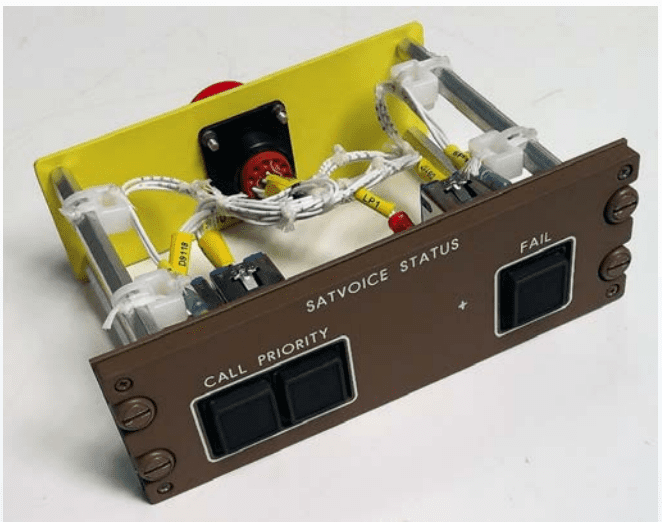
A satvoice status panel. Photo: L2 Aviation.
ICAO regulations, as well as those of local civil aviation regulators, require two long-distance radios for all trans-oceanic flights. Historically, that has always meant high-frequency (HF) radios.
As satellite coverage fills out and data transmission rates increase, there’s an argument that satellite-based voice communications (satvoice) could replace one — or both — of the HF radios on new and future aircraft and do their job better.
Being a good idea isn’t’ all that’s required for that kind of switch, though; there are all sorts of obstacles to getting a global industry like aviation to adopt new standards.
There are reasons to pursue it, though.
The average response time from controllers over an HF system is about 400 seconds, according to Inmarsat VP of Aviation Safety and Cybersecurity Joseph Texeira. Testing shows that over satvoice, that figure could drop as low as 10 seconds.
“Everybody wants to do this because this is a game changer,” Texeira said. The biggest reason is that call identification allows for prioritization.
The staunchest satvoice advocates include the two big satellite companies, Inmarsat and Iridium, service providers such as SITAONAIR, equipment developers such as Avionica and integrators such as L2 Aviation. In the near term, proponents have their eyes on replacing one of the two communications systems planes are required to carry with a satvoice system.
Ultimately, though, they want planes to be able to forego HF radios altogether in favor of two “dual-dissimilar” satvoice solutions — one leveraging Inmarsat’s satellite network and one leveraging Iridium’s. The two systems need to be on separate networks to create the redundancy that the regulators are seeking with the requirements.
The reasons to get there are compelling, according to L2 President Mark Lebovitz.
“If you were just to say to our customers, ‘You can pick between a short-wave radio and a high-tech cell phone — and, by the way, [the latter] one is cheaper and lighter — which do you want?’” the answer would be obvious, Texeira said.
“The idea of having HF radios that our grandparents were using … they’re not very clear and at times they’re not usable,” he said.
Outside of some impact from ionospheric activity and sunspots that doesn’t impact HF radios, satvoice should always be clearer and faster than HF. And there has been wide support—everyone agrees that it’s a better situation.
But there are hold-ups.
As always, regulatory change is slow. Companies have to show rulemakers that, in practice, satvoice is just as reliable as HF. They’re working on that.
In one effort last summer, Avionica COO Anthony Rios chaired a committee that brought Hawaiian Airlines, Jet Blue and UPS together to measure how long it takes to set up the call between an aircraft and air traffic control and what the quality is of that call. They advised the FAA that satvoice is a viable safety tool for long-range communications, which the FAA took into consideration for some new equipage rules for certain regions, which, Rios said, will make the U.S. the first region to let airlines replace one HF system with a satvoice system.
The big one is ICAO, though. Other bodies tend to follow ICAO’s lead and since the primary use case for HF and satvoice is transcontinental flights, the international body’s ruling is especially important.
“We don’t know when ICAO will be satisfied,” Texiera said, but that is where all of Inmarsat’s efforts are focused. The hope is that within the next year, the organization will adopt new language to facilitate satvoice.
When regulations do move to allow satvoice, though, they won’t likely do so explicitly; rather, the wording that requires HF radios will be changed so that instead of requiring certain equipment, the regulation will require certain capability. That way, any certified equipment that meets that capability can be used. That’s the way regulations are being written more often now, according to Rios, and that’s part of the effort to keep regulation from stifling technological advancement.
“The first part is removing any wording in the regulation that might hint toward HF, making it more generic and then making sure our products meet those regulations,” he said.
Another obstacle is infrastructure. While everyone might agree that satvoice is good in theory, not every country is set up to handle it, Lebovitz said, pointing to Australia as a prime example.
“They’re not set up to support two satcom calls. They don’t have the phone switch set up,” he said. “If a whole bunch of people started calling them, they wouldn’t have the people to support it.”
That’s something that Inmarsat is working on addressing in a partnership with Airservices Australia and SITAONAIR. SITA provides datalink services in Australia, and the air navigation service provider (ANSP) contracted Inmarsat earlier this year to evaluate the country’s connectivity infrastructure and ultimately use satvoice to enable direct controller-to-pilot communications beyond the reach of very high-frequency (VHF) radio, which is typically not more than 50 or 60 nautical miles.
Inmarsat’s customers have mostly been ANSPs so far. The ones investing in space-based ADS-B are primarily the ones investing in satvoice, according to Texeira. That should expand as regulations facilitate it.
There’s a cycle of regulation making companies feel that it’s worth investing in technologies which enable technological advancement that facilitates regulation change. That full suite is coming together at the right time now for relatively rapid change.
“This was never possible several years ago. The availability of voice-over-IP, digital switches, the necessary infrastructure of satellite service providers,” Texeira said. “How confident are we ATC facilities are going to prefer this method? I’m sure they’ll absolutely want to have the ability to intervene when something goes wrong. They do so in the VHF world on a regular basis.”
This article was originally published in our December/January issue. It has been edited. Click here to view the full version.